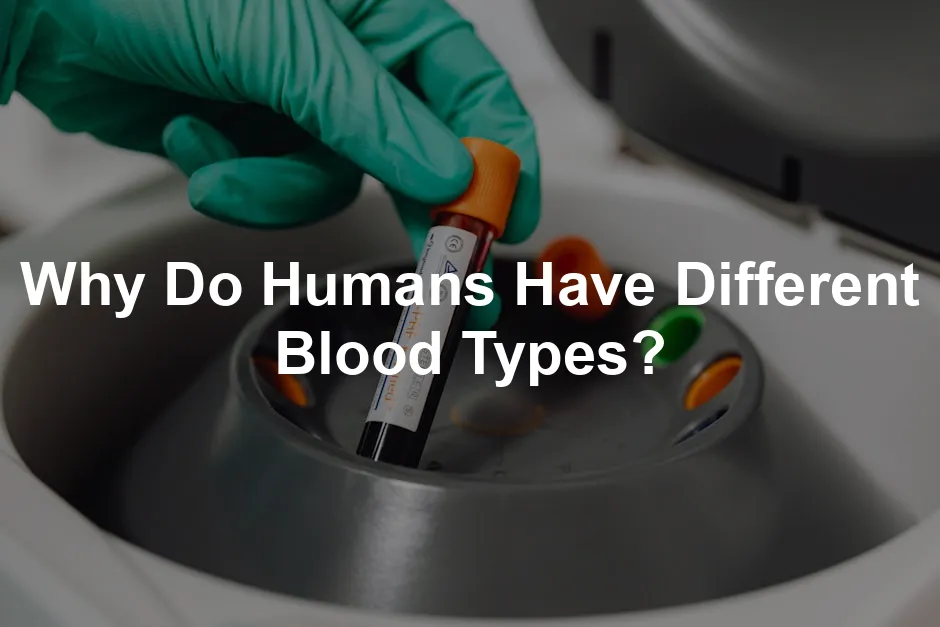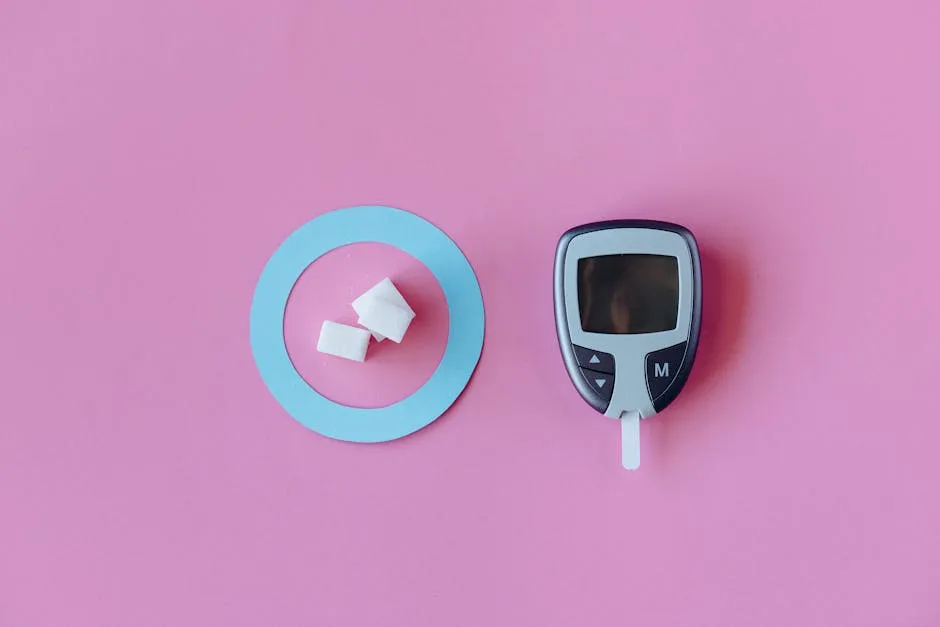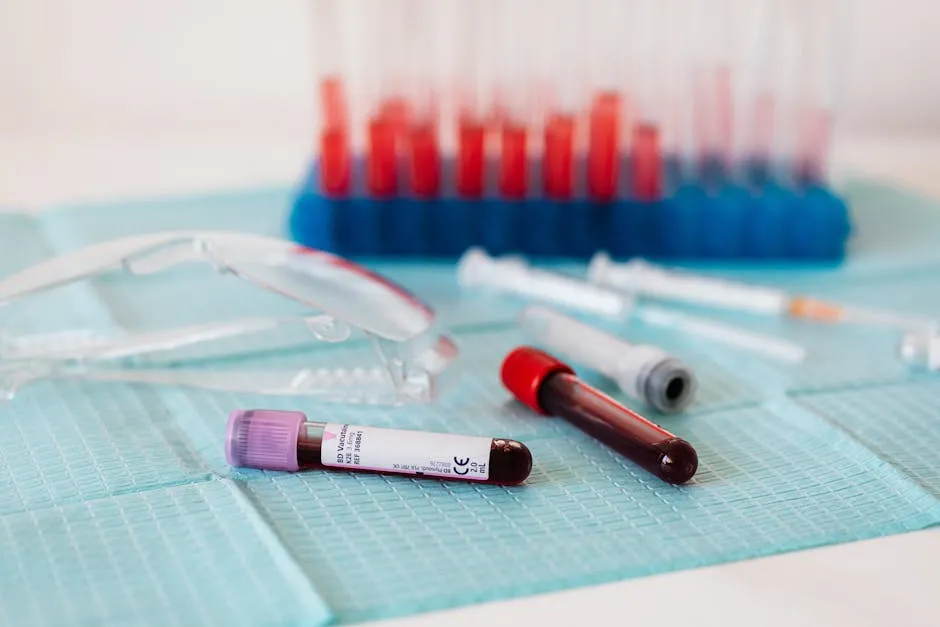
Why Do Humans Have Different Blood Types?
Introduction
Blood types are fascinating! They play a vital role in medicine, especially during blood transfusions and organ transplants. Imagine needing a blood transfusion and finding out your blood type is incompatible. Yikes! That’s where blood types come into play.
We have four main blood types: A, B, AB, and O, each with its own unique characteristics. But why do we even have these different blood types? It’s a question that tickles our curiosity. The existence of various blood types has baffled scientists for over a century.
Research continues into the origins of blood types and their implications for health. Some studies even suggest connections between blood types and susceptibility to certain diseases. So, while blood types may seem like just a medical detail, they hold a treasure trove of mysteries waiting to be uncovered. Understanding them can help us navigate the complexities of human biology and enhance our well-being.
If you’re curious about how your blood type can affect your health, consider checking out Blood Type Diet: A Scientific Approach to Your Health by Dr. Peter D’Adamo. This book dives into the connection between your blood type and diet, offering insights that could revolutionize your eating habits.
To delve deeper into the significance of blood types, you can read about why we have different blood types and what they mean.
The Discovery of Blood Types
Historical Context
The story of blood types kicks off in 1900, thanks to Austrian physician Karl Landsteiner. Picture this: Landsteiner mixed different blood samples and noticed something strange. Some combinations worked beautifully, while others led to utter chaos. This groundbreaking discovery earned him the Nobel Prize in Physiology or Medicine in 1930. His work laid the foundation for transfusion medicine.
Before Landsteiner, blood transfusions were a game of chance. Doctors had little understanding of compatibility. This ignorance often led to disastrous outcomes, which we can all agree is not ideal. Landsteiner classified blood into groups A, B, AB, and O. This classification was a game changer, as it explained why early transfusions were so hit or miss.
The significance of this discovery cannot be overstated. It ushered in a new era of safe blood transfusions. Understanding blood types prevents the dangerous clumping of blood cells during transfusions. Imagine receiving incompatible blood! It could lead to severe complications. Thanks to Landsteiner’s work, doctors can now ensure patients receive the right blood, minimizing risks.
So, the next time you hear about blood types, remember Karl Landsteiner. His curiosity and dedication changed the landscape of medicine forever. And speaking of changing landscapes, if you’re interested in broadening your knowledge on blood-related topics, check out Blood: An Epic History of Medicine and Commerce by Douglas Starr. It’s a riveting read that explores the historical significance of blood.

Understanding Blood Types
Blood types are like the unique fingerprints of our circulatory system. Most people are familiar with the four main blood groups: A, B, AB, and O. But what makes these blood types distinct? It’s all about the antigens and antibodies present in our blood. Let’s break it down.
The ABO Blood Group System
The ABO blood group system is a classification based on the presence or absence of specific antigens on the surface of red blood cells. Antigens are proteins that can trigger an immune response if they are foreign to the body. In this system, we have:
- Type A: Has A antigens and anti-B antibodies.
- Type B: Has B antigens and anti-A antibodies.
- Type AB: Contains both A and B antigens, but no antibodies.
- Type O: Lacks both A and B antigens but has both anti-A and anti-B antibodies.
When it comes to blood transfusions, compatibility is crucial. Here’s a quick compatibility guide:
- Type A: Can receive A and O blood.
- Type B: Can receive B and O blood.
- Type AB: The universal recipient; can receive any type.
- Type O: The universal donor; can give to any type.
Receiving incompatible blood can lead to severe reactions. Imagine your body getting a surprise party it didn’t sign up for! Clumping, or agglutination, occurs when antibodies attack foreign antigens, which can be life-threatening. Knowing your blood type is essential for safe transfusions.
The Rh Factor
Alongside the ABO system, we have the Rh factor, named after the Rhesus monkey in which it was first discovered. This factor is all about the presence of the RhD antigen. If you have this antigen, you’re Rh-positive; if not, you’re Rh-negative.
Why does this matter? The Rh factor is particularly significant during pregnancy. If an Rh-negative mother carries an Rh-positive baby, her immune system could produce antibodies against the baby’s blood, leading to complications. This condition, known as Rh incompatibility, can cause serious health issues for the newborn. That’s why prenatal blood tests are standard practice!
In terms of transfusions, Rh-negative individuals should ideally receive Rh-negative blood to avoid reactions. However, Rh-positive individuals can receive blood from either group.
Understanding both the ABO system and the Rh factor is essential for ensuring safe blood transfusions and managing health complications in pregnancy. So, the next time someone asks about your blood type, you’ll know it’s not just a trivial detail but a crucial piece of your health puzzle! And while we’re on the topic of health, consider investing in a Blood Pressure Monitor to keep track of your vital signs!

Evolutionary Theories Surrounding Blood Types
Theories of Origin
Why do we have different blood types? Scientists have proposed several intriguing theories. First up, we have the Primary Races Hypothesis. This theory suggests that blood groups evolved as different human populations emerged. Each race adapted uniquely to their environment, leading to the distinct blood types we see today.
Then there’s the Mutation Hypothesis. This one posits that all blood types originated from a single common ancestor—type O. Over time, mutations led to the development of types A, B, and AB. Imagine a game of genetic telephone where one simple message gets changed into something entirely new!
Next, we have the AB-First Hypothesis. According to this theory, type AB was the original blood group. It evolved into A and B over time. Picture it like a fancy cocktail that started with all the ingredients mixed together, then got shaken up and poured into separate glasses.
Environmental factors also play a role. For example, disease has been a significant influencer. In malaria-prone regions, type O blood is more common. Researchers believe that this blood type offers protection against severe malaria. It’s like nature’s way of equipping some folks with a special shield.
Disease Resistance and Blood Types
The links between blood types and disease resistance are fascinating! Research suggests that certain blood types can affect susceptibility to various infections. Let’s take malaria, for instance. Studies reveal that individuals with type O blood may have a lower risk of developing severe malaria. This is because infected red blood cells are less likely to clump together in people with type O.
Additionally, blood type influences vulnerability to other illnesses. Type A blood, for example, has been associated with higher risks of certain cancers. On the flip side, type O may offer some protection against cholera and other infections. It’s like a biological game of dodgeball, where some blood types seem to be better at avoiding the hits!
Moreover, blood antigens are found not only in red blood cells but also on various cells throughout the body. This widespread presence may explain the varying disease susceptibilities among blood types. In essence, these antigens could serve as a welcome mat for certain pathogens, inviting them in for a visit—or worse!
In summary, the evolutionary theories surrounding blood types are as diverse as the blood types themselves. Whether through natural selection or genetic mutation, understanding the origins of our blood types continues to spark curiosity and research. So, the next time you think about your blood type, remember, it’s not just a medical detail; it’s a fascinating piece of human history!

Genetic Basis of Blood Types
Inheritance Patterns
Blood types are a genetic inheritance puzzle. Each person inherits their blood type from their parents, much like eye color or height. The ABO blood group system, which includes types A, B, AB, and O, is determined by specific genes located on chromosome 9.
In our genetic makeup, we have alleles—different versions of a gene. For blood types, the main alleles are A, B, and O. A and B are dominant, while O is recessive. This means if you inherit an A allele from one parent and an O from the other, your blood type will be A. However, if you receive A from both parents, you’ll also be type A. Similarly, inheriting B from one parent and O from another results in B blood type.
Now, what about AB blood type? If you get an A allele from one parent and a B from the other, you become AB. So, your blood type isn’t just a lucky draw; it’s a genetic cocktail mixed from your parents’ contributions.
Understanding these inheritance patterns is crucial, especially in medical settings. For instance, if both parents are type O, their children will also be type O. But if one parent is A and the other O, their offspring might be either A or O. This genetic insight helps in predicting blood types in families and is essential for ensuring safe blood transfusions.
Practical Implications of Blood Types
Blood Transfusions and Compatibility
Knowing your blood type is more than trivia; it’s a lifesaver. In emergencies, when seconds count, incompatible blood transfusions can lead to severe complications. For instance, if a type A individual receives type B blood, their immune system could launch an all-out attack, treating the transfused blood as an enemy. Yikes!
This is where blood type compatibility comes into play. Blood type O is considered the universal donor. It can be given to anyone without triggering a reaction. Why? Because type O blood lacks A and B antigens, so it won’t provoke an immune response. On the flip side, type AB is the universal recipient and can accept blood from all types. This unique compatibility reduces the risk of transfusion reactions, making it vital for medical professionals to know their patients’ blood types.
Furthermore, the need for specific blood types varies among populations. For example, in diverse areas, the demand for certain blood types can be higher. Minorities may possess unique blood types that are essential for specific communities. Blood donation drives often focus on recruiting donors from these populations to meet the demand for unique blood types.
In summary, understanding blood types and their compatibility is crucial for safe medical practices. Whether you’re giving or receiving blood, knowing your blood type can make all the difference in ensuring a successful and safe transfusion. And if you’re looking to learn more about blood disorders, consider picking up a Medical Encyclopedia: Blood and Blood Disorders. It’s an essential resource for anyone interested in this topic!

Myths and Misconceptions
Blood types are often shrouded in myths and misconceptions. One popular belief is that blood types determine personality traits. According to this theory, people with type A are organized, while those with type B are more easy-going. Type O, supposedly, are natural leaders. However, these claims lack scientific backing. Your blood type doesn’t dictate whether you’re a neat freak or a free spirit. Sorry, folks, but that’s just a reach!
Another common myth is the idea that certain diets are optimal for specific blood types. The Blood Type Diet, popularized by Dr. Peter D’Adamo, suggests that consuming foods based on your blood type can lead to better health. However, research hasn’t validated these claims. Nutrition should be personalized, focusing on individual health needs rather than blood types. If you’re interested in exploring this diet further, grab The Blood Type Diet Cookbook: 150 Recipes for a Healthy Blood Type by Dr. Peter D’Adamo. It provides delicious recipes tailored for each blood type!
People also mistakenly believe that being O negative means you’re free from health issues. While O negative is a universal donor type, it doesn’t confer immunity to diseases. Each blood type has its advantages and disadvantages, but all require proper care and attention.
In truth, understanding blood types is essential for medical reasons, particularly during transfusions. But attributing personality traits or dietary needs to them? That’s just a myth waiting to be busted!
FAQs
What are the different blood types?
There are four main blood types: A, B, AB, and O. – Type A: Has A antigens with anti-B antibodies. – Type B: Has B antigens with anti-A antibodies. – Type AB: Contains both A and B antigens, but no antibodies. – Type O: Lacks both antigens, but has both anti-A and anti-B antibodies.
How do blood types affect transfusions?
Compatibility is crucial for safe blood transfusions. – Type A can receive A and O blood. – Type B can receive B and O blood. – Type AB is the universal recipient and can accept any type. – Type O is the universal donor, safe for any recipient.
Can blood types change?
Blood types generally remain the same throughout life. However, rare changes can occur due to bone marrow transplants or certain medical conditions.
Why is O negative considered the universal donor?
O negative blood lacks A and B antigens, making it safe for anyone to receive. This quality is crucial during emergencies when blood type is unknown.
Are there health risks associated with certain blood types?
Some studies suggest links between blood types and health conditions. For instance, type A may have a higher risk of stomach cancer, while type O may be more susceptible to certain infections. However, these associations require further research to understand fully.
Please let us know what you think about our content by leaving a comment down below!
Thank you for reading till here 🙂
Also, if you’re looking to stay fit and healthy, consider a Fitness Tracker to monitor your daily activity levels!
All images from Pexels




